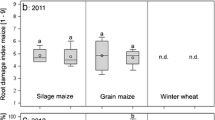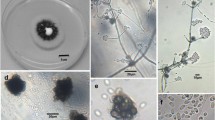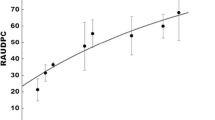Abstract
Aims
The study aimed to assess comparatively the accuracy and efficiency of three culture media protocols for estimating black-foot disease pathogens populations in soils and to examine how shifts in the abundance and composition of black-foot pathogens correspond to changes in specific soil properties.
Methods
Firstly, culture media were compared by evaluating the mycelial growth of selected black-foot pathogens and by estimating the population of Dactylonectria torresensis from artificially infested soils. Secondly, the most efficient culture medium was selected for estimating the viable propagules of black-foot disease pathogens in eight naturally infested soils. An analysis of the soil physicochemical properties was conducted. Data were statistically analyzed in order to explore possible relationships between the studied variables.
Results
Glucose-Faba Bean Rose Bengal Agar (GFBRBA) was selected as the most efficient culture medium. All naturally infested soils tested positive for the presence of black-foot pathogens. D. torresensis was the most frequently isolated species, followed by Dactylonectria alcacerensis and Ilyonectria liriodendri. A positive relationship between calcium carbonate and the Colony-Forming Units (CFUs) level of black-foot pathogens in soil was obtained.
Conclusions
In this study, we provide an early, specific, and accurate detection of viable propagules of black-foot pathogens in soil, which is critical to understand the ecology of these fungi and to design effective management strategies.



Similar content being viewed by others
Abbreviations
- CEC:
-
Cation Exchange Capacity
- CFU:
-
Colony-Forming Unit
- EC:
-
Electric conductivity
- GFBA:
-
Glucose-Faba Bean Agar
- GFBRGA:
-
Glucose-Faba Bean Rose Bengal Agar
- ITS:
-
Internal Transcribed Spacer
- MRBA:
-
Modified Rose Bengal Agar
- NMDS:
-
Non-Metric Multidimensional Scaling Analysis
- LSD:
-
Least Significant Difference
- PCA:
-
Principal Component Analysis
- PCR:
-
Polymerase Chain Reaction
- PDA:
-
Potato Dextrose Agar
- PDAC:
-
Potato Dextrose Agar supplemented with 250 mg l−1 of chloramphenicol
- SNA:
-
Spezieller Nährstoffarmer Agar
- SOM:
-
Soil Organic Matter
References
Agustí-Brisach C, Armengol J (2013) Black-foot disease of grapevine: an update on taxonomy, epidemiology and management strategies. Phytopathol Mediterr 52:245–261
Agustí-Brisach C, Gramaje D, León M, García-Jiménez J, Armengol J (2011) Evaluation of vineyard weeds as potential hosts of black-foot and petri disease pathogens. Plant Dis 95:803–810
Agustí-Brisach C, Gramaje D, García-Jiménez J, Armengol J (2013a) Detection of black-foot disease pathogens in the grapevine nursery propagation process in Spain. Eur J Plant Pathol 137:103–112
Agustí-Brisach C, Gramaje D, García-Jiménez J, Armengol J (2013b) Detection of black-foot and petri disease pathogens in natural soils of grapevine nurseries and vineyards using bait plants. Plant Soil 364:5–13
Agustí-Brisach C, Mostert L, Armengol J (2014) Detection and quantification of Ilyonectria spp. associated with black-foot diseases of grapevine in nursery soils using multiplex nested PCR and quantitative PCR. Plant Pathol 63:316–322
Agustí-Brisach C, Cabral A, González-Domínguez E, Pérez-Sierra A, León M, Abad-Campos P, García-Jiménez J, Oliveira H, Armengol J (2016) Characterization of Cylindrodendrum, Dactylonectria and Ilyonectria isolates associated with loquat decline in Spain with description of Cylindrodendrum alicantinum sp. nov. Eur J Plant Pathol 145:103–118
Aiello D, Guarnaccia V, Epifani F, Perrone G, Polizzi G (2015) 'Cylindrocarpon' and Ilyonectria species causing root and crown rot disease of potted laurustinus plants in Italy. J Phytopathol 163:675–680
Alaniz S, Leon M, García-Jiménez J, Abad P, Armengol J (2007) Characterization of Cylindrocarpon species associated with black-foot disease of grapevine in Spain. Plant Dis 91:1187–1193
Booth CD (1966) The genus Cylindrocarpon. Mycol Pap (CMI) 104:1–56
Boughton TJ, Malajczuk N, Robson AD (1978) Suppression of infection of jarrah roots by Phytophthora cinnamomi with application of calcium carbonate. Aust J Bot 26:611–615
Brant JB, Myrold DD, Sulzman EW (2006) Root controls on soil microbial community structure in forest soils. Oecologia 148:650–659
Brayford D (1993) Cylindrocarpon. In: Singleton LL, Mihail JD, Rush CM (eds) Methods for research on Soilborne Phytopathogenic fungi. APS Press, St. Paul, pp 103–106
Brown JK, Tellier M (2011) Plant-parasite coevolution: bridging the gap between genetics and ecology. Annu Rev Phytopathol 49:345–367
Cabello M, Arambarri A (2002) Diversity in soil fungi from undisturbed and disturbed Celtis tala and Scutia buxifolia forests in the eastern Buenos Aires province. Argentina, Microbiol Res 157:115–125
Cabral A, Groenewald JZ, Rego C, Oliveira H, Crous PW (2012a) Cylindrocarpon root rot: multi-gene analysis reveals novel species within the Ilyonectria radicicola species complex. Mycol Prog 11:655–688
Cabral A, Rego C, Nascimento T, Oliveira H, Groenewald JZ, Crous PW (2012b) Multi-gene analysis and morphology reveal novel Ilyonectria species associated with black foot disease of grapevines. Fungal Biol 116:62–80
Cardoso M, Diniz I, Cabral A, Rego C, Oliveira H (2013) Unveiling inoculum sources of black foot pathogens in a commercial grapevine nursery. Phytopatol Mediterr 52:298–312
Carlucci A, Lops F, Mostert L, Halleen F, Raimondo ML (2017) Occurrence fungi causing black foot on young grapevines and nursery rootstock plants in Italy. Phytopatol Mediterr, doi:10.14601/Phytopathol_Mediterr-18769
Chaverri P, Salgado C, Hirooka Y, Rossman AY, Samuels GJ (2011) Delimitation of Neonectria and Cylindrocarpon (Nectriaceae, Hypocreales, Ascomycota) and related genera with Cylindrocarpon-like anamorphs. Stud Mycol 68:57–78
Cho JH, Rupe JC, Cummings MS, Gbur EE (2001) Isolation and identification of Fusarium solani f sp glycines from soil on modified Nash and Syder’s medium. Plant Dis 85:256–260
Crous PW, Groenewald JZ, Risede JM, Hywel-Jones NL (2004) Calonectria species and their Cylindrocladium anamorphs: species with sphaeropedunculate vesicles. Stud Mycol 50:415–429
Damm U, Fourie PH (2005) A cost-effective protocol for molecular detection of fungal pathogens in soil. South Afr J Sci 101:135–139
Davis JR, Huisman OC, Everson DO, Schneider AT, Sorensen LH (1999) Suppression of Verticillium wilt with wheat and improved yield and quality of the russet Burbank potato. Am J Potato Res 76:254
Demanèche S, Jocteur-Monrozier L, Quiquampoix H, Simonet P (2001) Evaluation of biological and physical protection against nuclease degradation of clay-bound plasmid DNA. Appl Environ Microbi 67:293–299
Easton GD, Nagle ME, Seymour MD (1992) Potato production and incidence of Verticillium dahliae following rotation to nonhost crops and soil fumigation in the state of Washington. Am Potato J 69:489–502
Edel V, Steinberg C, Gautheron N, Alabouvette C (1997) Populations of nonpathogenic Fusarium oxysporum associated with roots of four plant species compared to soilborne populations. Phytopathology 87:693–697
Elmholt S, Labouriau R, Hestbjerg H, Nielsen LM (1999) Detection and estimation of conidial abundance of Penicillium verrucosum in soil by dilution plating on a selective and diagnostic agar medium (DYSG). Mycol Res 103:887–895
England LS, Lee H, Trevors JT (1997) Persistence of Pseudomonas aureofaciens strains and DNA in soil. Soil Biol Biochem 29:1521–1527
Erper I, Agustí-Brisach C, Tunali B, Armengol J (2013) Characterization of root rot disease of kiwifruit in the Black Sea region of Turkey. Eur J Plant Pathol 136:291–300
Gandon S, Michalakis Y (2002) Local adaptation, evolutionary potential and host–parasite coevolution: interactions between migration, mutation, population size and generation time. J Evolution Biol 15:451–462
Gardes M, Bruns TD (1993) ITS primers with enhanced specificity for basidiomycetes: application to the identification of mycorrhizae and rusts. Mol Ecol 2:113–118
Gramaje D, Armengol J (2011) Fungal trunk pathogens in the grapevine propagation process: potential inoculum sources, detection, identification, and management strategies. Plant Dis 95:1040–1055
Halleen F, Crous PW, Petrini O (2003) Fungi associated with healthy grapevine cuttings in nurseries, with special reference to pathogens involved in the decline of young vines. Australas Plant Pathol 32:47–52
Halleen F, Fourie PH, Crous PW (2006) A review of black foot disease of grapevine. Phytopathol Mediterr 45:S55–S67
Halleen F, Fourie PH, Crous PW (2007) Control of black foot disease in grapevine nurseries. Plant Pathol 56:637–645
Hunter BB, Sylvester MA, Balling J (1980) A rapid method for identifying and recovering species of Cylindrocladium from soil via geranium leaf baiting and a selective agar medium. Proc Pennsylvania Acad Sci 54:157–151
Jeewon R, Hyde KD (2007) Detection and diversity of fungi from environmental samples: traditional versus molecular approaches. In Advanced Techniques in Soil Microbiology 11:1–15
Jones RK, Benson DM (2003) Diseases of woody ornamentals and trees in nurseries. APS Press, St. Paul, MN, p 482
Kaiser C, Koranda M, Kitzler B, Fuchslueger L, Schnecker J, Schweiger P, Rasche F, Zechmeister-Boltenstern S, Sessitsch A, Richter A (2010) Belowground carbon allocation by trees drives seasonal patterns of extracellular enzyme activities by altering microbial community composition in a beech forest soil. New Phytol 187:843–858
Lannou C, Mundt CC (1997) Evolution of a pathogen population in host mixtures: rate of emergence of complex races. Theor App Genet 94:991–999
Lombard L, Bezuidenhout CM, Crous PW (2013) Ilyonectria black foot rot associated with Proteaceae. Australas Plant Pathol 42:337–349
Lombard L, Van Der Merwe NA, Groenewald JZ, Crous PW (2014) Lineages in Nectriaceae: re-evaluating the generic status of Ilyonectria and allied genera. Phytopathol Mediterr 53:515–532
Mehlich A (1984) Mehlich-3 soil test extractant: a modification of Mehlich-2 extractant. Commun Soil Sci Plant Anal 15:1409–1416
Nelson DW, Sommers LE (1982) Total carbon, organic carbon, and organic matter. In: Page AL et al (eds) Methods of soil analysis, part 2. SSSA, Madison, Wisc, pp 539–594
Oksanen J, Kindt R, Legendre P, O’Hara B, Simpson GL, Stevens MHH (2008) Vegan: community ecology package, version 1.11–4. http://vegan.r-forge.r-project.org
Orsini L, Remy JC (1976) Utilisation du chlorure de cobaltihexammine pour la determina-tion simultanée de la capacité d’échange et des bases échangeables des sols. Scie Sol 4:269–275
Petit E, Barriault E, Baumgartner E, Wilcox WF, Rolshausen PE (2011) Cylindrocarpon species associated with black-foot of grapevine in northeastern United States and southeastern Canada. Am J Enol Viticult 62:177–183
Probst C, Jaspers M, Jones EE, Ridgway HJ (2010) A quantitative PCR method for detecting two Cylindrocarpon species in soil. Phytopathol Mediterr 49:115
R Core Team (2016) R: A language and environment for statistical computing. R Foundation for Statistical Computing, Vienna, Austria. URL https://www.R-project.org/
Reedler RD, Capell BB, Tomlinson LD, Hickey WJ (2003) The extraction of fungal DNA from multiple large soil samples. Can J Plant Pathol 25:182–191
Reis P, Cabral A, Nascimento T, Oliveira H, Rego C (2013) Diversity of Ilyonectria species in a young vineyard affected by black foot diseases. Phytopathol Mediterr 52:335–346
Schmitthenner AF, Canaday CH (1983) Role of chemical factors in development of Phytophthora diseases. In: Erwin DC, Bartnicki-Garciaand S, Tsao PH (eds) Phytophthora: its biology, taxonomy, ecology and pathology. APS Press, St. Paul, pp 189–196
Schroers HJ, Zerjav M, Munda A, Halleen F, Crous PW (2008) Cylindrocarpon pauciseptatum sp. nov., with notes on Cylindrocarpon species with wide, predominantly 3-septate macroconidia. Mycol Res 112:82–92
Singleton LL, Mihail JD, Rush CM (1993) Methods for research on Soilborne Phytopathogenic fungi. APS Press, St. Paul, p 265
Spiegel Y, Netzer D, Kafkafi U (1987) The role of calcium nutrition on fusarium-wilt syndrome of muskmelon. J Phytopathol 118:220–226
Tolosa-Almendros VM, Lerma ML, Castillo P, Armengol J, Muñoz RM (2016) Identificación de especies de Dactylonectria e Ilyonectria en plantas de vid con síntomas de decaimiento. Abstracts of the XVIII Congress of the Spanish Plant Pathology Society
Turner RT, Ramakrishnan K, Walshaw J, Heavens D, Alston M, Swarbreck D, Osbourn A, Grant A, Poole PS (2013) Comparative metatranscriptomics reveals kingdom level changes in the rhizosphere microbiome of plants. ISME J 7:2248–2258
Wickham H, Chang W (2016) Devtools: tools to make developing R packages easier R package version 1.12.0. https://CRAN.R-project.org/package=devtools
Woltz SS, Jones JP (1981) Nutritional requirements of Fusarium oxysporum: basis for a disease control system. In: Nelson RE, Toussoun TA, Cook RJ (eds) Fusarium: diseases, biology and taxonomy. Penn St Univ Press, University Park, pp 340–349
Zarraonaindia I, Owens SM, Weisenhorn P, West K, Hampton-Marcell J, Lax S, Bokulich NA, Mills DA, Martin G, Taghavi S, van der Lelie D, Gilbert JA (2015) The soil microbiome influences grapevine-associated microbiota. mBio 6(2):e02527–e02514
Acknowledgements
The research was funded by CAR (Government of La Rioja, Spain), under the project “Characterization, epidemiology and control of fungal trunk pathogens of grapevine in La Rioja” (project number R-03-16). We thank “Instituto Navarro de Tecnologías e Infraestructuras Agroalimentarias” (INTIA), Spain, which collected the soil samples from the field in Olite for further use in the experiment. We thank P. Yécora and M. Andrés for technical assistance. David Gramaje was supported by the DOC-INIA program from the National Institute for Agronomic Research (INIA), co-funded by the European Social Fund. Carmen Berlanas was supported by the FPI-INIA program from the INIA. Beatriz López was supported by the PhD program from the Government of La Rioja.
Author information
Authors and Affiliations
Corresponding author
Additional information
Responsible Editor: Stéphane Compant.
Rights and permissions
About this article
Cite this article
Berlanas, C., López-Manzanares, B. & Gramaje, D. Estimation of viable propagules of black-foot disease pathogens in grapevine cultivated soils and their relation to production systems and soil properties. Plant Soil 417, 467–479 (2017). https://doi.org/10.1007/s11104-017-3272-3
Received:
Accepted:
Published:
Issue Date:
DOI: https://doi.org/10.1007/s11104-017-3272-3




